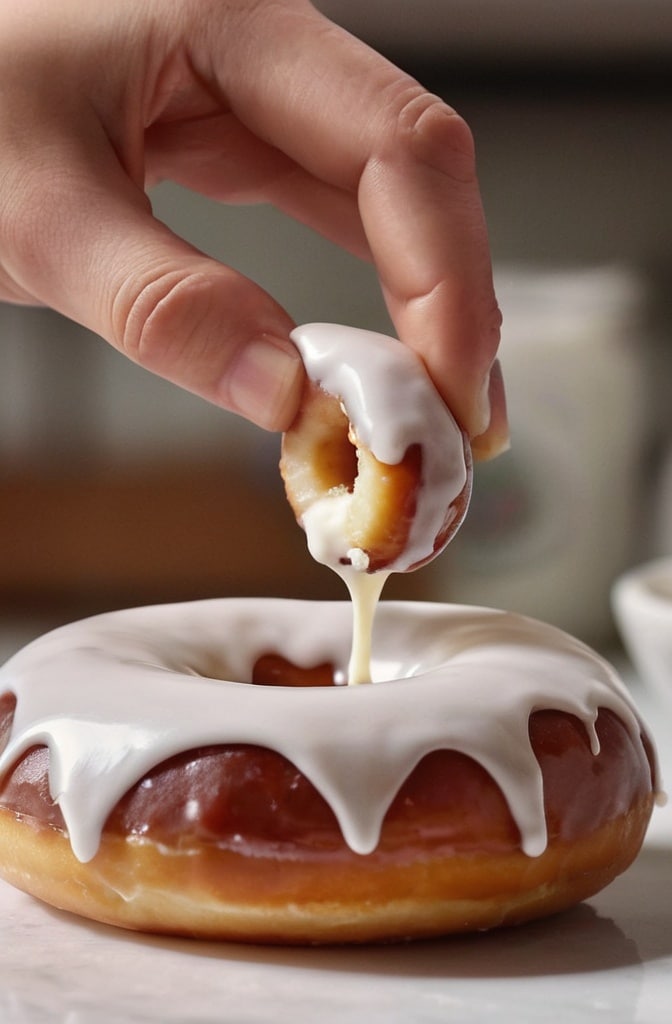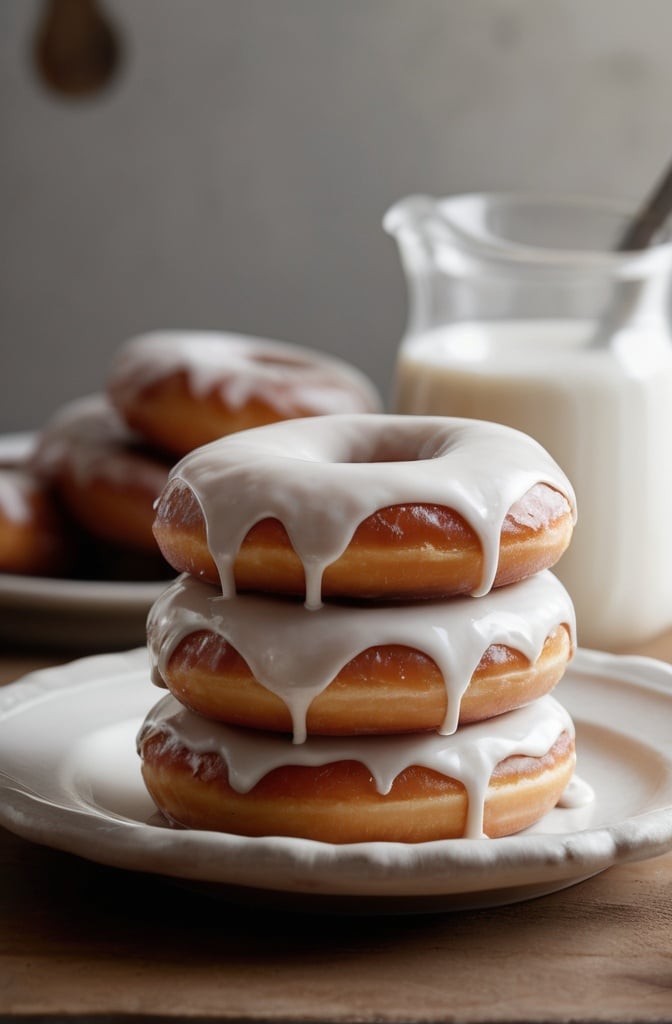There’s something almost magical about that first bite into a freshly fried Old Fashioned Doughnuts with Sour Cream the way the crunchy, craggly exterior gives way to a tender, cake-like interior, all enveloped in a sweet, tangy glaze that crackles between your teeth. I’ve spent nearly two decades perfecting these nostalgic treats, and let me tell you, Old Fashioned Doughnuts with Sour Cream have truly earned their place in the pantheon of American pastries for good reason.
Old fashioned doughnuts aren’t just doughnuts they’re time machines. They transport us back to corner bakeries where doughnuts were made by hand and served with steaming cups of coffee in thick ceramic mugs. What makes these doughnuts special is their distinctive cracked exterior, which provides more surface area for that delectable sour cream glaze to cling to, creating perfect pockets of sweetness in every bite.
Understanding Old Fashioned Doughnuts
Unlike their yeasted counterparts, old fashioned doughnuts rely on chemical leaveners (baking powder and soda) to create their signature texture. This produces a heartier, cake-like crumb with a more substantial bite. The cracked surface—perhaps their most distinguishing feature—forms when the cold dough hits hot oil, causing the exterior to expand rapidly while the interior remains dense.
The origins of the old fashioned doughnut trace back to the mid-19th century, though precicely when they first appeared remains somewhat contested. What we do know is that by the 1930s, they had become staples in American doughnut shops, valued for their keeping qualities and distinctive appearance. They’ve since maintained their popularity alongside fancier, more elaborate doughnut variations.
Today’s recipe balances historical accuracy with modern techniques. We’ll create doughnuts that honor tradition while incorporating subtle refinements that ensure consistently excellent results every single time.
Ingredients & Substitutions
For the Doughnuts:
- 280g (2¼ cups) all-purpose flour
- 150g (¾ cup) granulated sugar
- 1½ teaspoons baking powder
- ½ teaspoon baking soda
- 1 teaspoon kosher salt
- ¼ teaspoon freshly grated nutmeg
- 2 large eggs, room temperature
- 115g (½ cup) sour cream, room temperature
- 2 tablespoons unsalted butter, melted and cooled
- 2 teaspoons vanilla extract
- Vegetable oil for frying (about 2 quarts)
For the Sour Cream Glaze:
- 240g (2 cups) powdered sugar, sifted
- 60g (¼ cup) sour cream
- 2-3 tablespoons whole milk
- ½ teaspoon vanilla extract
- Pinch of kosher salt
The flour choice matters tremendously here—I prefer a mid-protein all-purpose flour (around 10-11% protein). Higher protein flours create tougher doughnuts, while cake flour makes them too delicate for frying. If your seeking a more tender result, you could substitute up to 50g of the all-purpose flour with cake flour.
For those avoiding dairy, coconut cream works surprisngly well in place of sour cream in both the dough and glaze, though it adds a subtle coconut flavor. Plain, full-fat Greek yogurt makes an excellent sour cream substitute that maintains the necessary tang and fat content.
The nutmeg is non-negotiable—it’s what gives old fashioned doughnuts their distinctive flavor profile. Always use freshly grated nutmeg if possible; the pre-ground stuff simply doesn’t compare and lacks the essential aromatic oils that make these doughnuts sing.
Step-by-Step Instructions

Preparing the Dough:
- In a large bowl, whisk together flour, sugar, baking powder, baking soda, salt, and nutmeg until well combined. This thorough mixing ensures even distribution of leavening agents, which is critical for that perfect crackly exterior.
- In a separate bowl, whisk together eggs, sour cream, melted butter, and vanilla until smooth. The temperature of these ingredients is crucial—too cold, and the butter will solidify; too warm, and you’ll develop too much gluten when mixing.
- Pour the wet ingredients into the dry ingredients and gently fold together using a rubber spatula until just combined. Overmixing is the enemy here; stop when you no longer see dry flour. The dough will be sticky and somewhat loose—exactly what we want.
- Cover the bowl with plastic wrap, making sure it touches the surface of the dough to prevent skinning, and refrigerate for at least 1 hour or overnight. This resting period allows the flour to fully hydrate and the gluten to relax, resulting in more tender doughnuts.
Rolling and Cutting:
- On a well-floured surface, roll the chilled dough to approximately ½-inch thickness. The dough is quite sticky, so don’t be shy with the flour. If it feels too soft, return it to the refrigerator for 15-20 minutes.
- Using a 3-inch doughnut cutter (or two round cutters: 3-inch for the outer edge and 1-inch for the hole), cut out doughnuts, dipping the cutter in flour between cuts to prevent sticking. Try to cut them as close together as possible to minimize scraps.
- Transfer cut doughnuts and holes to a floured baking sheet. The dough scraps can be gently rerolled once, but be aware that these second-generation doughnuts won’t be quite as tender as the first batch. I sometimes fry the scraps as irregular pieces—chef’s treat!
Frying:
- Heat oil in a heavy-bottomed pot or Dutch oven to 350°F (175°C). Temperature control is absolutley critical—too hot and the outsides burn before the insides cook; too cool and the doughnuts absorb excess oil. A digital thermometer is incredibly helpful here.
- Carefully lower 2-3 doughnuts into the hot oil, being careful not to crowd the pot. The temperature will drop when you add the dough, so adjust your heat as needed to maintain around 350°F. These need proper space to expand and form those signature cracks.
- Fry for about 2 minutes per side, or until deep golden brown. You’ll notice the doughnuts crack almost immediately after entering the oil—this is exactly what we want! Those cracks create more surface area for the glaze and contribute to the doughut’s iconic look.
- Remove doughnuts with a slotted spoon or spider and drain on a wire rack set over a baking sheet. Don’t use paper towels, which can steam the bottom of the doughnuts and compromise their texture. Allow to cool for about 5 minutes before glazing.
Preparing the Glaze:
- While the doughnuts cool slightly, whisk together powdered sugar, sour cream, 2 tablespoons milk, vanilla, and salt in a medium bowl until smooth. The glaze should be thick but pourable—think honey consistency. Add more milk if needed, but go slowly; a tablespoon makes a big difference.
- For a variation, you might add 1 tablespoon of maple syrup to the glaze, reducing the milk slightly to maintain the proper consistency. Or add 2 teaspoons of fresh lemon juice and ½ teaspoon of zest for a bright citrus kick.
- Dip each slightly cooled (but still warm) doughnut into the glaze, allowing excess to drip back into the bowl, then place on the wire rack to set. For an extra-rich finish, double-dip once the first layer has set (about 5 minutes).
The Science Behind Perfect Old Fashioned Doughnuts
The magic of old fashioned doughnuts lies in the physical transformation that occurs during frying. When cold dough meets hot oil, the exterior cooks rapidly while the inside remains cool. This temperature differential causes the outside to set while the leavening agents are still creating gas bubbles, resulting in the characteristic cracks as the doughnut expands.

Sour cream plays three crucial roles in this recipe: its acidity activates the baking soda, its fat content tenderizes the dough, and its tangy flavor balances the sweetness. It’s also responsible for the slight density that distinguishes old fashioned doughnuts from other cake doughnuts.
The initial cooling period between frying and glazing is another critical step. If glazed while too hot, the glaze simply runs off; if too cool, it won’t adhere properly. That 5-minute sweet spot allows the glaze to partially melt into the surface while still forming that distinctive, crackly finish as it sets.
Serving & Pairing Suggestions
Old fashioned doughnuts are at their absolute peak within the first few hours after glazing, when the contrast between the crunchy exterior and tender interior is most pronounced. After 24 hours, they’ll still be delicious but will gradually soften as moisture equalizes throughout the doughnut.
These pastries were born to be enjoyed with coffee—the slight bitterness of a medium-dark roast beautifully complements the sweet, tangy glaze. For an elevated breakfast service, try pairing with cold brew coffee poured over ice cream (affogato-style) for a indulgent contrast of temperatures and textures.
For a dessert application, slightly warm old fashioned doughnuts make an exceptional base for a deconstructed trifle. Layer quartered doughnuts with lightly sweetened whipped cream, macerated berries, and a drizzle of aged balsamic for a sophisticated take on strawberry shortcake.
Creative bakers might also consider transforming day-old doughnuts into bread pudding. Cube the doughnuts, soak in a custard base enhanced with bourbon and cinnamon, and bake until puffed and golden for a transcendent dessert that gives these classics new life.
Storage & Make-Ahead Tips
While best enjoyed fresh, these doughnuts can be stored in an airtight container at room temperature for up to two days. Avoid refrigerating them, as the cold air accelerates staling. If you must extend their life, freezing unglazed doughnuts works remarkably well—defrost at room temperature and apply fresh glaze before serving.
The dough itself can be prepared up to 24 hours in advance and kept refrigerated. In fact, an overnight rest often improves the flavor as the ingredients have more time to meld. The longer rest also allows the flour to fully hydrate, resulting in more tender doughnuts.
For those looking to prepare partially in advance, you can cut the doughnuts and keep them refrigerated for up to 4 hours before frying. Any longer and they may dry out, affecting the final texture.
Conclusion
Old fashioned doughnuts represent American baking at its finest—unpretentious yet technically nuanced, rustic in appearance yet complex in execution. The crackly, glazed exterior giving way to that tender, cake-like interior creates a textural experience that few other pastries can match.
What sets truly exceptional old fashioned doughnuts apart is attention to detail: proper temperature control during frying, respecting the crucial resting periods, and glazing at precisely the right moment. Master these elements, and you’ll create doughnuts that rival those from the most celebrated bakeries.
Remember that perfection comes with practice. Your first batch might not crack exactly right or may absorb too much oil, but each attempt brings you closer to doughnut nirvana. There’s something deeply satisfying about preserving this baking tradition—one crackly, glazed ring at a time.
FAQs About Old Fashioned Doughnuts with Sour Cream
Why didn’t my doughnuts develop the characteristic cracks?
The signature cracks form when cold dough hits hot oil. If your doughnuts didn’t crack, either your dough wasn’t cold enough (try freezing for 15 minutes before frying) or your oil temperature was too low. Always wait for the oil to return to 350°F between batches.
Can I bake these doughnuts instead of frying them?
While you can technically bake this dough in a doughnut pan at 350°F for about 12-14 minutes, the result won’t be a true old fashioned doughnut. Baked versions lack the characteristic crackling exterior and crisp edges that make these pastries special. The texture will be more like coffee cake than a proper doughnut.
Why is my glaze too runny/too thick?
Glaze consistency depends on several factors, including the exact moisture content of your sour cream and powdered sugar. For runny glaze, add more sifted powdered sugar, 1 tablespoon at a time. For thick glaze, add milk ½ teaspoon at a time—it takes very little liquid to significantly thin a glaze.
How can I create chocolate old fashioned doughnuts?
To make chocolate old fashioned doughnuts, substitute 25g (¼ cup) of the flour with unsweetened cocoa powder and add an additional 25g (2 tablespoons) of sugar to balance the bitterness. For the glaze, add 2 tablespoons of cocoa powder and increase the milk slightly to maintain the proper consistency.
My doughnuts are too dense/heavy. What went wrong?
Dense doughnuts usually result from overmixing the dough (which develops too much gluten) or using flour with too high a protein content. Mix just until ingredients are combined, and consider using a lower-protein all-purpose flour. Also check that your leavening agents are fresh—both baking powder and baking soda lose potency over time.

